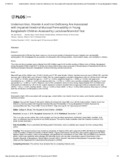Undernutrition, vitamin A and iron deficiency are associated with impaired intestinal mucosal permeability in young Bangladeshi children assessed by lactulose/mannitol test
Date
2016-12Publisher
© 2017 Public Library of ScienceAuthor
Hossain, Md IqbalHaque, Rashidul
Mondal, Dinesh
Mahfuz, Mustafa
Ahmed, Am Shamsir
Islam, Mohammad Munirul
Guerrant, Richard Littleton
Petri, William Arthur
Ahmed, Tahmeed J.
Metadata
Show full item recordCitation
Hossain, M. I., Haque, R., Mondal, D., Mahfuz, M., Ahmed, A. M. S., Islam, M. M., . . . Ahmed, T. (2016). Undernutrition, vitamin A and iron deficiency are associated with impaired intestinal mucosal permeability in young bangladeshi children assessed by lactulose/mannitol test. PLoS ONE, 11(12)10.1371/journal.pone.0164447Abstract
Background: Lactulose/mannitol (L:M) test has been used as a non-invasive marker of intestinal mucosal-integrity and -permeability (enteropathy). We investigated the association of enteropathy with anthropometrics, micronutrient-status, and morbidity in children. Methods: The urine and blood samples were collected from 925 children aged 6±24 months residing in Mirpur slum of Dhaka, Bangladesh during November 2009 to April 2013. L:M test and micronutrient status were assessed in the laboratory of International Centre for Diarrhoeal Diseases Research, Bangladesh (icddr,b) following standard procedure. Results: Mean±SD age of the children was 13.2±5.2 months and 47.8% were female. Urinary-lactulose recovery was 0.264±0.236, mannitol recovery was 3.423±3.952, and L:M was 0.109 ±0.158. An overall negative correlation (Spearman's-rho) of L:M was found with age (rs = -0.087; p = 0.004), weight-for-age (rs = -0.077; p = 0.010), weight-for-length (rs = -0.060; p = 0.034), mid-upper-arm-circumference (rs = -0.098; p = 0.001) and plasma-retinol (rs = -0.105; p = 0.002); and a positive correlation with plasma α-1-acid glycoprotein (rs = 0.066; p = 0.027). However, most of the correlations were not very strong. Approximately 44% of children had enteropathy as reflected by L:M of ≥0.09. Logistic regression analysis revealed that younger age (infancy) (adjusted odds ratio (AOR) = 1.35; p = 0.027), diarrhea (AOR = 4.00; p = 0.039) or fever (AOR = 2.18; p = 0.003) within previous three days of L:M test were the risk factors of enteropathy (L:M of ≥0.09). Conclusions: Enteropathy (high L:M) is associated with younger age, undernutrition, low vitamin A and iron status, and infection particularly diarrhea and fever.
Keywords
Vitamin ADescription
This article was published in the PLoS ONE [© 2016 Public Library of Science] and the definitive version is available at: http://doi.org/10.1371/journal.pone.0164447 The Journal's website is at: http://journals.plos.org/plosone/article?id=10.1371/journal.pone.0164447Department
James P Grant School of Public Health, BRAC UniversityType
ArticleCollections
- Article [9]
- Article [4]
- Faculty Publications [111]

